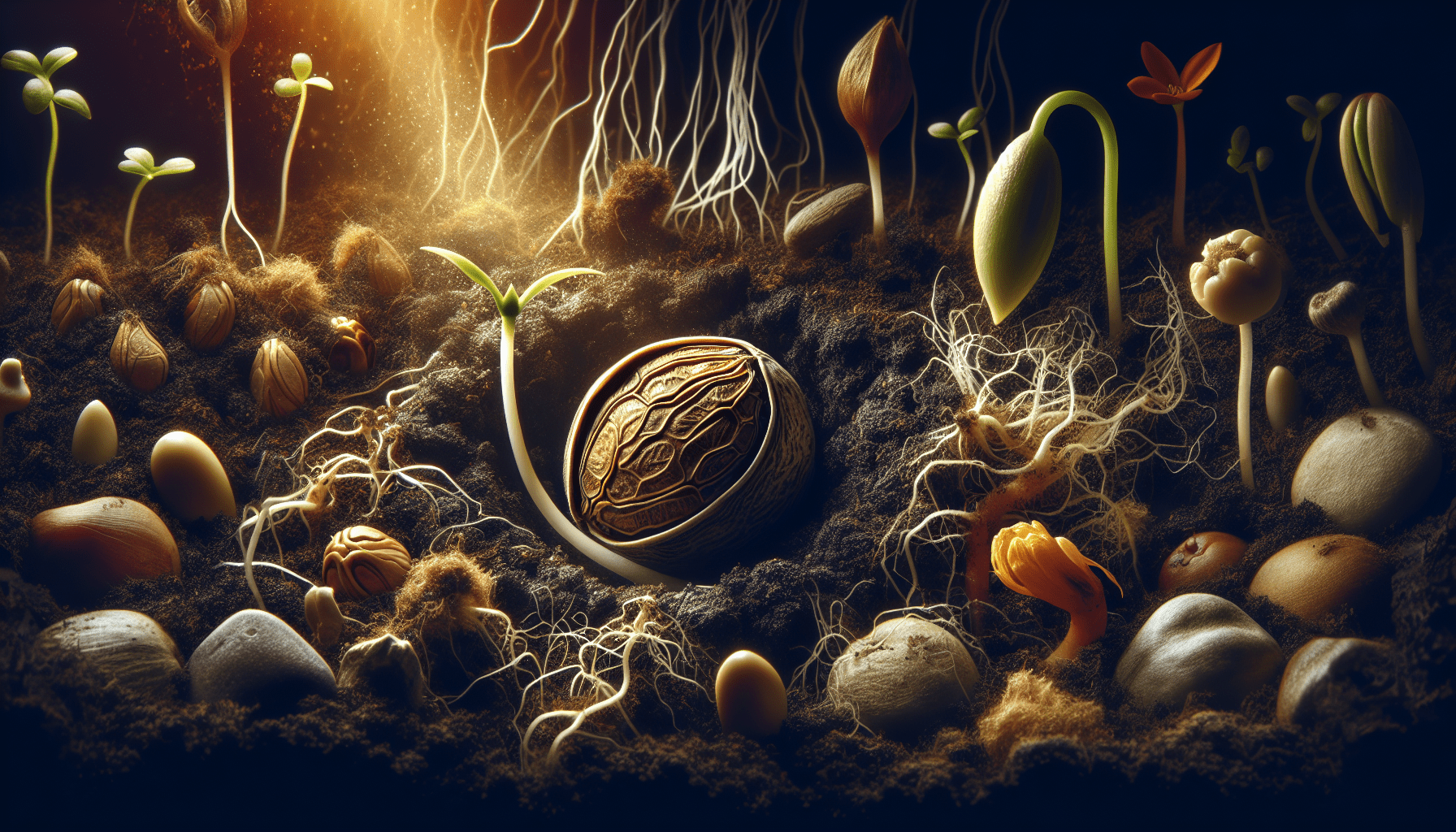This post may contain affiliate links which means I may receive a commission for purchases made through links. Learn more on my Private Policy page.
Imagine you stumble upon a forgotten packet of seeds hidden at the back of your gardening drawer. You can’t help but feel a twinge of disappointment as you notice that they look old and damaged. But don’t toss them away just yet! In this article, we will explore some simple yet effective techniques to revive old or damaged seeds. Whether you’re a seasoned gardener or a novice, these tips will give you a chance to breathe new life into those neglected seeds and witness the beauty of nature unfold before your eyes. So, let’s get started on this journey of seed revival together!

Understanding Seed Viability
What is seed viability?
Seed viability refers to the ability of a seed to germinate and grow into a healthy plant. In simple terms, it is the measure of how likely a seed is to successfully sprout and develop into a seedling under favorable conditions. Seed viability is crucial for gardening and agricultural purposes, as it determines the success rate of planting and the overall productivity of crops.
Factors affecting seed viability
Several factors can influence seed viability, including age, storage conditions, genetic factors, and exposure to environmental factors. As seeds age, their viability naturally declines, and their ability to germinate decreases. Storage conditions, such as moisture and temperature levels, also play a significant role in maintaining seed viability. Genetic factors, such as the inherent characteristics of a particular plant species, can impact seed viability as well. Additionally, exposure to unfavorable environmental factors like extreme temperatures or pests can reduce seed viability.
Determining seed viability
It is essential to evaluate the viability of seeds before planting them to ensure the highest chances of successful germination. Various methods can be employed to determine seed viability, such as conducting a germination test or performing a seed viability assay. These tests involve planting a sample of seeds and observing their germination rate over a specific period. By comparing the number of seeds that successfully germinate to the total number planted, one can estimate the overall viability of the seed batch.
Evaluating Seed Damage
Identifying signs of seed damage
Identifying signs of seed damage is crucial to determine whether the seeds are viable and capable of germination. Some common signs of seed damage include cracking or splitting of the seed coat, discoloration, mold growth, insect infestation, and a foul smell. Additionally, damaged seeds may appear shriveled, unusually small, or deformed compared to healthy seeds.
Common causes of seed damage
Seed damage can occur due to various reasons, including improper storage conditions, exposure to moisture, pest infestation, physical damage during harvesting or processing, or age-related deterioration. If seeds are exposed to excess moisture, they can become susceptible to fungal and bacterial growth, leading to rot and decay. Similarly, pests like insects or rodents can damage seeds by feeding on them or introducing pathogens. Mishandling and improper storage can also lead to physical damage, resulting in reduced seed viability.
Assessing the extent of seed damage
It is essential to assess the extent of seed damage to determine whether the seeds are salvageable or not. By carefully inspecting the seeds and comparing their condition with healthy ones, you can determine the severity of the damage. If only a small percentage of seeds are damaged, it may be possible to salvage the rest through proper care and germination techniques. However, if a significant portion of the seeds are damaged or deteriorated, it is advisable to consider obtaining fresh seeds for a higher chance of successful germination.
Seed Storage and Preservation
Proper seed storage techniques
Proper storage techniques play a vital role in maintaining seed viability over an extended period. The ideal storage conditions involve keeping seeds in a cool, dry, and dark environment. It is essential to protect the seeds from exposure to light, moisture, and extreme temperature fluctuations, as these factors can decrease seed viability. Storing seeds in airtight containers, such as glass jars or sealed plastic bags, can help create a stable microenvironment and prevent moisture absorption.
Containers and moisture control
Selecting suitable containers for seed storage is crucial to maintaining seed viability. Glass or metal containers that can be tightly sealed are preferred to prevent moisture and air exchange. Additionally, using moisture-absorbing desiccants, such as silica gel packets or powdered milk, can help control humidity levels and reduce the risk of mold or fungal growth. It is important to store seeds in a cool, dry place away from direct sunlight or heat sources.
Storage temperature and environment
Temperature plays a crucial role in seed storage. Most seeds survive best when stored at temperatures between 32°F (0°C) and 41°F (5°C). However, certain seeds require specific temperature conditions for optimal storage, known as stratification. Stratification involves subjecting seeds to a period of cold temperature to break their dormancy and stimulate germination. By understanding the specific temperature requirements of seeds, you can ensure their long-term viability during storage.
Enhancing Seed Germination
Scarification: Breaking seed coat dormancy
Seed coat dormancy is a natural protective mechanism that prevents seeds from germinating under unfavorable conditions. Scarification involves mechanically or chemically breaking the seed coat to allow water and oxygen to penetrate the seed, initiating germination. Mechanical scarification techniques include nicking the seed coat with a knife or rubbing the seeds with sandpaper. Chemical scarification involves treating the seeds with acid or a weak bleach solution to soften the seed coat.
Stratification: Cold treatment for certain seeds
Stratification is a technique used to simulate the natural winter conditions required by specific seeds for successful germination. It involves subjecting the seeds to a period of cold temperature, usually in the range of 32°F (0°C) to 41°F (5°C), for a specific duration. Cold treatment breaks seed dormancy and prepares the seeds for germination once favorable conditions are provided. Different seeds have varying stratification requirements, so it is crucial to research the specific needs of the seeds you are working with.
Soaking and rehydration methods
Soaking seeds before planting can help kickstart the germination process by rehydrating the seed coat and initiating metabolic activity. Soaking seeds in room temperature water for a few hours or overnight can improve their chances of successful germination. Additionally, using rehydration methods such as moist paper towel or vermiculite can provide the necessary moisture for seeds to rehydrate and begin the germination process. It is important not to oversoak or overhydrate seeds, as excessive water can lead to rot or fungal growth.

Pre-germination Techniques
Seed viability testing
Before sowing seeds, conducting a seed viability test can help determine the percentage of viable seeds in a batch. Several test methods, such as the float test or the tetrazolium test, can be employed to assess seed viability. The float test involves placing seeds in water and observing whether they sink or float. Viable seeds generally sink, while non-viable seeds tend to float. The tetrazolium test involves treating seeds with a red dye that stains living tissues, allowing you to identify viable seeds based on their color.
Pre-sowing treatments
Pre-sowing treatments refer to a range of techniques employed to improve the germination success of seeds. These treatments include scarification, stratification, soaking, and pre-soaking seeds in various solutions like hydrogen peroxide or liquid seaweed extract. The goal is to provide optimal conditions for seeds to break dormancy and initiate growth. By applying these treatments, you can increase the chances of successful germination and enhance the overall vigor of seedlings.
Seed priming methods
Seed priming is a technique that involves partially hydrating seeds before sowing to improve their germination and early growth rates. This technique enhances the speed and uniformity of germination and can help overcome seed dormancy and stress tolerance. Priming seeds can be achieved by soaking them in water for a specified period, followed by drying them back slightly before planting. The controlled hydration-dehydration process triggers the seeds’ metabolic activities without allowing them to fully germinate.
Seedling Care and Nutrition
Ideal growing conditions for seedlings
Creating the ideal growing conditions for seedlings is essential to ensure their healthy development. Seedlings require adequate light, moisture, and air circulation for optimal growth. Place seedlings in a location that receives plenty of indirect sunlight, preferably near a window or under grow lights. Ensure proper air circulation by providing ventilation or using a small fan to prevent the development of mold or damping-off disease. The temperature should be kept within a suitable range for the specific plant species.
Providing adequate light and water
Light is crucial for seedling growth, and insufficient light can lead to weak, spindly seedlings. If natural light is not sufficient, supplement it with fluorescent or LED grow lights to provide the needed intensity and spectrum. Moreover, water seedlings regularly, but avoid overwatering, as excessive moisture can cause root rot or other fungal diseases. Maintain a consistent level of moisture in the soil or growing medium to ensure healthy root development.
Using organic fertilizers and amendments
To provide seedlings with essential nutrients, organic fertilizers and soil amendments can be used to enhance their growth and vigor. Organic fertilizers, such as compost or well-rotted manure, slowly release nutrients into the soil, nourishing the seedlings over time. Soil amendments like vermiculite or perlite can improve soil drainage and aeration, promoting better root development. It is advisable to follow the recommended application rates and timing for organic fertilizers and amendments to avoid nutrient imbalances or plant damage.
Seed Dormancy Breakers
Smoke treatments and plant hormones
Smoke treatments and plant hormones can be used to break seed dormancy and stimulate germination in certain plant species. Smoke treatments utilize chemicals present in smoke, which mimic the natural fire-related cues that trigger germination in specific plants. Plant hormones, such as gibberellins, can also be applied externally to mimic natural hormonal signals and promote seed germination. These methods can be particularly useful for exotic or rare plants that require specific cues for successful germination.
Cold stratification and warm stratification
Stratification, both cold and warm, can be employed to overcome seed dormancy in various plant species. Cold stratification involves simulating winter conditions by subjecting seeds to a cold, moist environment for a specified duration. Warm stratification, on the other hand, involves providing seeds with a period of warm temperature to stimulate germination. The specific requirements for stratification vary among plant species, and understanding the needs of the seeds you are working with is crucial for successful germination.
Alternating temperatures and light exposure
Another method to break seed dormancy is subjecting seeds to alternating temperature conditions or exposure to light. Some seeds require fluctuating temperatures to simulate natural seasonal changes, which break dormancy and initiate germination. Similarly, exposing seeds to light or darkness for specific durations can trigger germination in certain plant species. These techniques can be valuable for unlocking the dormancy of seeds that rely on specific environmental cues for germination.
Seed Scarification Techniques
Physical scarification methods
Physical scarification involves physically altering the seed coat to improve water and oxygen uptake during germination. This technique can be achieved through methods such as nicking the seed coat with a knife, rubbing the seeds with sandpaper, or gently filing the seed coat with a nail file. By creating small openings or thinning the seed coat, physical scarification promotes better water absorption and allows the seed to break dormancy more easily.
Chemical scarification options
Chemical scarification involves treating seeds with chemicals that soften or weaken the seed coat, facilitating germination. Common chemicals used for scarification include sulfuric acid, hydrogen peroxide, or a weak bleach solution. Seeds are soaked in these solutions for a specified duration, after which they are washed and rinsed thoroughly to remove any remaining traces of the chemical. Chemical scarification must be conducted with caution and proper safety measures to prevent harm to oneself or the environment.
Using hot water and acid treatments
Hot water and acid treatments are effective methods of scarification for certain seed types. In hot water scarification, seeds are soaked in near-boiling water for a brief period, followed by soaking them in cool water. This process helps to soften the seed coat and promote germination. Acid scarification involves treating seeds with acidic solutions like sulfuric acid or vinegar for a short duration, followed by thorough rinsing. These treatments can enhance the germination success of seeds with hard or impermeable seed coats.
Seed Saving and Preservation
Collecting and cleaning mature seeds
To save and preserve seeds for future use, it is important to collect mature seeds from healthy, disease-free plants. Allow the seed pods or capsules to dry and turn brown on the plant before harvesting. Once harvested, remove the seeds from the pods or capsules and separate them from any remaining plant debris. Cleaning the seeds by gentle rubbing, sieving, or winnowing can help remove any remaining debris, ensuring the seeds are clean and ready for storage.
Drying and storing seeds properly
Proper drying and storage techniques are crucial for preserving seed viability over an extended period. After cleaning, spread the seeds in a single layer on a dry tray or paper towel, allowing them to dry thoroughly in a well-ventilated area. It is essential to ensure that the seeds are completely dry before storing them, as excess moisture can lead to mold or fungal growth. Once dry, store the seeds in airtight containers, such as glass jars or sealed envelopes, and label them with the plant name and date of collection.
Long-term seed preservation techniques
Long-term seed preservation techniques, such as cold storage or seed banks, can help maintain seed viability for many years. Cold storage involves storing seeds in airtight containers at low temperatures, such as in a refrigerator or freezer. Seeds stored in this manner can remain viable for a more extended period. Seed banks, which are specialized facilities for storing and preserving seeds, maintain controlled conditions of temperature, humidity, and light to ensure long-term seed viability. These preservation methods are particularly valuable for rare or endangered plant species.
Tips for Successful Seed Germination
Labeling and organizing seeds
Proper labeling and organization of seeds are essential to avoid confusion and ensure the correct identification of seeds during the germination process. Label each set of seeds with the plant species name, variety, and the date of collection or purchase. Additionally, keeping a record of seed sources, planting dates, and any specific requirements can be helpful for future reference. Storing seeds in labeled envelopes or small containers and organizing them by plant type or characteristics can further streamline the germination process.
Providing optimal growing conditions
Creating optimal growing conditions is vital for successful seed germination. Consider factors such as light, temperature, moisture, and soil quality when selecting the planting location for your seeds. Provide sufficient light, moisture, and appropriate temperature levels to match the requirements of the specific plant species. Additionally, using high-quality soil or growing medium suited for seed starting can improve the chances of successful germination and seedling development.
Patience and monitoring progress
Patience is key when it comes to seed germination. Different plant species have varying germination times, and some seeds may take longer to sprout than others. It is important to regularly monitor the progress of your seeds, ensuring they receive proper care and attention. Keep track of the germination rate, the emergence of seedlings, and any signs of growth or potential issues. Adjust your care routine accordingly and provide additional support, such as staking or transplanting, as the seedlings develop.
In conclusion, understanding seed viability, evaluating seed damage, proper seed storage techniques, enhancing seed germination, pre-germination techniques, seedling care and nutrition, seed dormancy breakers, seed scarification techniques, seed saving and preservation, and tips for successful seed germination are all crucial aspects of successful gardening and seed propagation. By following these guidelines and implementing the appropriate techniques, you can maximize the viability and germination success of your seeds, ensuring a bountiful garden and thriving plants. Happy gardening!
This post may contain affiliate links which means I may receive a commission for purchases made through links. Learn more on my Private Policy page.

